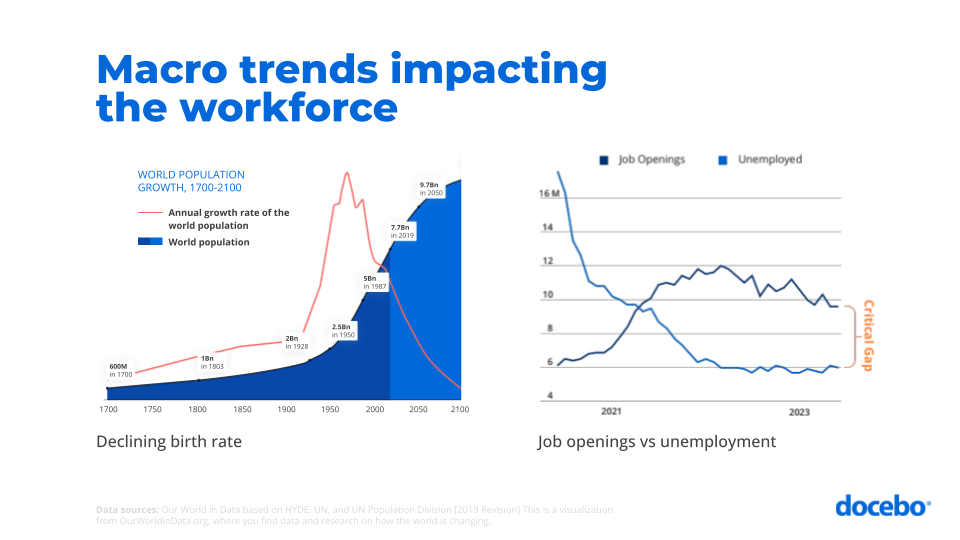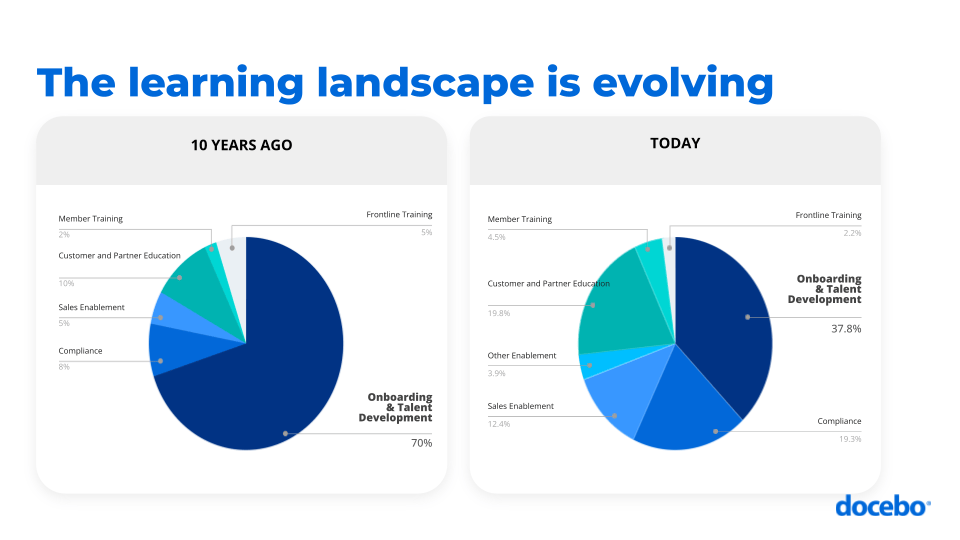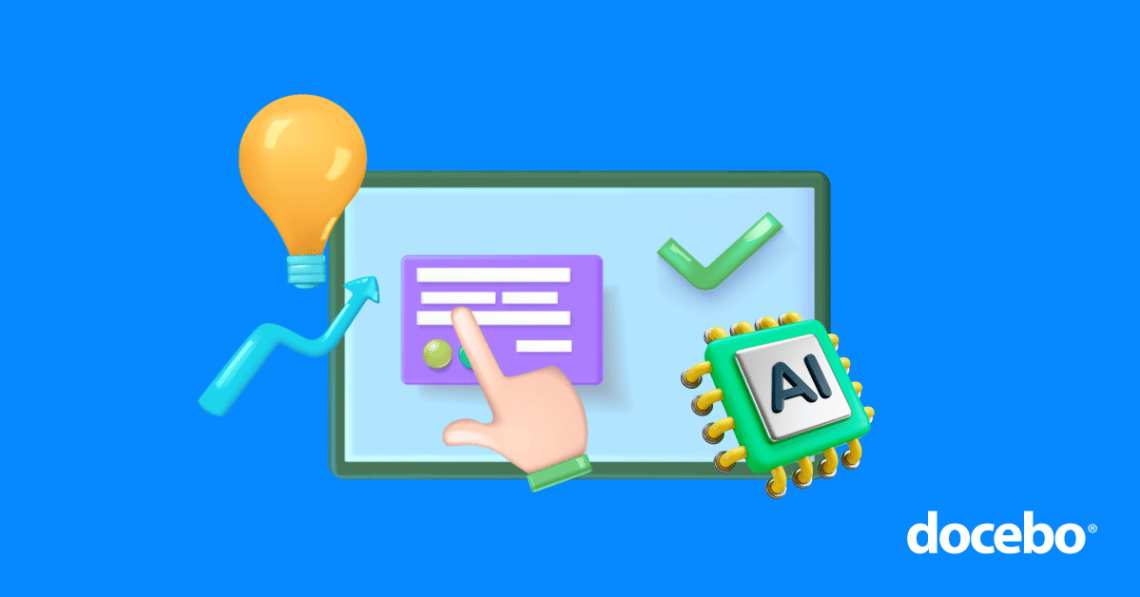Repeat after me…AI is here to help us!
Seriously! This isn’t going to end like a sci-fi story, with beep-booping robots taking over the world through their nefarious machinations.
The AI revolution will be much friendlier. But it will still transform online learning. Let’s use these super-advanced tools, like Generative AI, to personalize your learning program’s content while perfecting its automation capabilities.
 A transmission from an alternate dimension?
A transmission from an alternate dimension?
The possibilities seem endless, so where to begin? Why not take a look at Docebo’s recent webinar, Driven By Innovation. Powered by AI. With the help of our subject matter experts, we preview what the next generation of your LMS will look like with the power of Generative AI at its core.
A full recording of this webinar is available to watch now. Read on for the four main reasons learning professionals should pay attention to AI.
Reason #1: AI is adapting quickly (and we’re quickly adopting AI)
Before anything else, let’s think about how incredibly far AI has come in an extremely short time. When Siri first popped up on iPhones just over a decade ago, the tech felt fun and fresh, but chances are you treated it as a novelty, not a global disruptor. (Is there anyone among us who hasn’t shouted “Ok Google!” or “Alexa!” to request their friend’s least-favourite song?)
Smart assistants like Siri or Alexa have come a long way. But their capabilities seem quaint compared to ChatGPT, Midjourney, Notion, and Bard.
These Generative AI tools use AI to (wait for it) generate text and images based on a simple question or prompt. If it can be written, generative AI can produce it – wedding speeches, lines of code, a recipe for vegan banana bread, a haiku about bees, or literally anything else you can imagine. It’s incredible.
How big is generative AI? We’ll give you these stats to gnaw on:
- It took Facebook 10 months to reach one million users. Pretty impressive, right?
- But wait! Instagram took only two and a half months to get the million mark.
- So, how long did it take ChatGPT? Just five…count ‘em on your fingers…days.
That incredible growth isn’t going to stop anytime soon, either. Today, there are more than 200 million users on ChatGPT, and one estimate predicts it will pass the billion user mark in 2025. If 1 in 8 people in the world will be using something, best to pay attention to what that thing can do!
Reason #2: AI is filling the workforce gap
Did you know that worldwide productivity growth is slowing? It’s true; and the size of the workforce is slowly diminishing as well.
Right now, there are more job openings available than the number of people unemployed. This critical gap has existed since 2021, and it’s only getting wider.

Population growth is slowing, and there is already a historic number of job openings. Businesses can’t get the people they need to maintain productivity.
So as it turns out, the fear that AI will take away our jobs isn’t really as warranted as the fear that businesses won’t have enough skilled workers! Organizations focused on learning aren’t protected from this trend. But Generative AI can help them beat it.
The workplace of the near future will use its human workforce more strategically. We’ll provide the creativity, the critical thinking, and of course, that human touch. Meanwhile, we’ll have AI do the heavy lifting in producing content quickly and efficiently.
Reason #3: As AI is evolving, so is the learning landscape
On top of this labour shortage, we also have to contend with another tough assignment: We need to produce more content.
Our research at Docebo and from other orgs has uncovered a few telling tidbits:
- 10 years ago, the majority of training was focused internally. Onboarding and compliance alone took up 70% of all training!
- Today’s corporate learning is much more integrated; and more external. More than 70% of organizations deliver training to learners outside of the organization, usually customers and partners.
- In the LMS market alone, there are twice as many opportunities for external training compared to internal training.

Business learning used to be mainly about onboarding and talent development. Today, new use cases like sales enablement and customer training are significant opportunities and drive growth for the businesses that do them right.
Naturally though, with larger audiences comes more programs to deliver and more content to produce. Once you start focusing externally, then the work required to meet those demands start to scale up quickly.
Reason #4: AI is simply better at certain tasks
Consider a test we performed at Docebo, where we compared the time and cost it took for both a skilled professional and AI to create learning content for sales enablement training.
- A skilled professional needs over 40 hours to create this learning content, costing $10,000.
- Meanwhile, AI could do the same job in only 3 minutes, with a price tag of only 30 cents. (What’s the last thing you bought for 30 cents?!)
That means Generative AI can do the same job 800 times faster and 30,000 times cheaper! Why not, then, have AI take care of this work, and give more time for the experts to strategize and innovate?
2 ways to integrate AI in the workforce
How will adopting AI look in practice? Two paths lay ahead:
In the Centaur Approach, we let AI handle the repetitive, hard work (the horse part of the centaur), while we take care of the strategic thinking and planning (the human part).
In the Cyborg Approach, the division of labour between us and AI is more integrated: We work hand-in-hand with AI, even on creative work.
Either way, remember this: AI absolutely loves data. The more data you give your learning program’s AI, the better it will get!
What does the future of learning look like with AI? Expect 3 benefits
Better, faster, smarter. Kind of like the Daft Punk song.

Here are the three main benefits of working with AI:
Benefit #1: The future of learning is better
Here at Docebo, we’re already big fans of AI for its potential in personalization. Concepts like adaptive learning and personalized learning pathways that respond to the learner are incredible keys that can unlock learner success in your LMS.
WIth AI-powered learning, you can simply innovate easier. For one, the ability to analyze the behaviours and preferences of your learners and then recommend targeted content to match their needs. This is key to driving engagement within your learning program.
Benefit #2: The future of learning is faster
The potential of AI to automate and speed up processes that would otherwise take much longer is definitely of the biggest advantages.
Docebo once worked with an organization that sold GPS systems. This business wanted to train retail associates all around the world on how to sell their products. However, there wasn’t a lot of time between when a new product finished R&D and when it went to the market.
Creating effective content for this training program was a challenge! Had AI been an option back then, we could have automated these processes and made that training content available to the learners more quickly.
Benefit #3: The future of learning is smarter
Remember: AI loves data. If your company is using data responsibly, then it should be using that data to train AI and optimize the learner experience for every audience you have.
For example, Docebo’s AI is getting smarter by the day, all because we are building the cognitive architecture that will allow it to sit within our LMS and utilize our data effectively. Simply put, we’re creating space for our AI to learn and grow.
What’s the outcome? Learners will have access to the right content, at the right time, in their language, and across various content types. What about introducing built-in activities, virtual simulations, and knowledge checks to maximize knowledge retention? Why not? AI turns ‘impossible’ into ‘possible’ and ‘possible’ into ‘doable.’
What can your learning program do with AI *now*?
- Use a virtual coach. A proactive learning coach, who understands each learner and their role on your platform, can guide and steer your learners continuously through their learning activities. They can also make personalized content recommendations. Speaking of which…
- Make personalized content recommendations. Suggest content based on a learner’s role, their activity in the platform, other training they’ve taken, and more. The beauty of AI is that your recommendation system can be tailored to what you want your learners to focus on!
- Find better content with AI-powered deep search. We’ve also developed deep search functionality, where content is searched not only for its metadata (like title and description) but also for the actual content itself. The AI ‘takes your training’ and can then properly serve it up to learners when they need it most.
- Create content quicker with Docebo Shape. We’re particularly proud of this one! With Docebo Shape and its AI magic, you can create content in minutes when it would normally take hours—or longer. And with its ability to personalize and edit easily, Shape can empower experts to become creators.
- Save time with skills tagging. As your learning content gets uploaded to the platform, AI automatically analyzes and identifies the key topics and use cases and tags them. That way, as soon as the content finishes uploading, it can be recommended to learners right away – no human administration needed!
What can your learning program do in the future?
Our research into AI at Docebo is giving us a sneak peak of what’s around the corner. Here’s what’s coming:
Pedagogically-informed learning
Docebo’s AI is built using a cognitive infrastructure that enhances the cognitive function of the user. Which is just a fancy way of saying that activities, interactions, and assessments will be tailored to meet the learner where they are as an individual.
Since AI is keeping track of each learner’s unique progress, learning content can be continuously adapted to ensure maximum knowledge retention. This will also accelerate talent mobility and upskilling as learners will grow faster and learn more.
Full control over data
Data privacy is obviously a huge concern. But what if we use AI to tackle that challenge, too? Docebo will provide access to an AI panel, giving organizations full control over their own data. That way, they can decide how (and if) AI-driven algorithms should be used. (And of course, Docebo provides data anonymization on our own LLM to ensure data privacy and control.)
Remember these key takeaways
If you can only remember two things, remember that AI will help build these two crucial pillars supporting your learning success:
- Personalization. AI makes it possible to scale the creation and delivery of personalized learning experiences, thereby increasing engagement.
- Automation. AI takes away the heavy lifting on the back end, streamlining processes and saving time.
If you focus your AI efforts here, you’ll see your learning program transform.
Take content authoring and the learner experience to the next level
“If the computer is the bicycle for your mind, AI is the rocketship that will give you superpowers.” – Giuseppe Tomasello, Vice President of Artificial Intelligence at Docebo
Take it from us at Docebo, because we’ve been pioneering AI into our LMS solutions for years now. AI-powered tools like Shape are a new approach to content design and delivery that will create more hyper-personalized experiences where content actively reacts to the learners’ input.
And be sure to stay tuned: There will be many more exciting AI developments to come.
Get the full picture
Want to see a demonstration of this AI in action, including Docebo Shape? Watch the full recording of this webinar, Driven By Innovation. Powered by AI.

